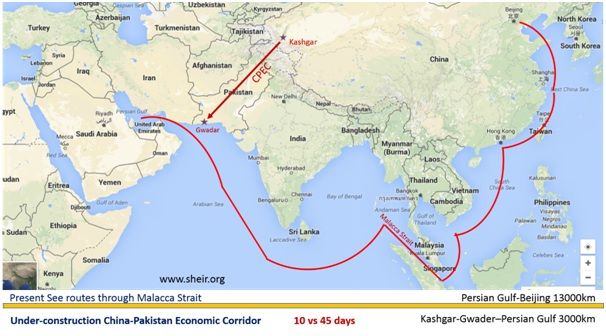What is the issue?
- China has been actively pursuing India’s participation in its BRI project.
- In this context, if things go smoothly, the opening up of Indo-Pak cross border trade is also likely as a consequence.
How is the BRI influencing Indo-Pak dynamics?
- India has always seen China as an irritant in Indo-Pak relationship.
- But currently a number of factors might be at work in the north western region, to usher in a more positive “Indo-China-Pakistan” axis.
- Context - Beijing is seeking to extend “China-Pakistan Economic Corridor” (CPEC) projects to India, in order to make it more remunerative for all.
- Significantly, CPEC is part of Chinese President Xi Jinping’s ambitious and expansive “Belt and Road Initiative” (BRI).
- Other countries in the region “Afghanistan, Iran, and the Central Asian Republics” have already responded very positively to the BRI.
- Problem - Delhi has voiced against CPEC as a matter of policy as it passes through Gilgit-Baltistan (PoK), which is a territory claimed by India.
- Further, India’s long standing view that projects under BRI are economically unsustainable is another major impediment for any compromise.
How can these issues be addressed?
- Beijing led diplomacy to improve Indo-Pak ties may aid in addressing India’s political concerns with CPEC.
- If China portrayed genuine neutrality on the Kashmir question, it could make it a lot easier for Delhi to become part of CPEC.
- The differences on economics of the BRI project can easily be overcome by negotiating terms on specific projects alone on a case by case basis.
- Further, despite strategic and historical reasons, Pakistan too has a lot to gain by admitting India into its infrastructural mesh.
What are the benefits for Pakistan from all this?
- Pakistan is currently undergoing a period of extreme macro-economic stress and is on the verge of seeking foreign loans to support its budgets.
- The incoming PM Imran Khan has stated that instead of borrowing international, he wants to revive the economy through indigenous means.
- Letting India export its goods to Afghanistan and Central Asia through Pakistan’s territory is of the ways to boost Pakistan’s economy.
- Apart from helping Pakistan earn a handsome transit fee, it will also open up more business opportunity for truckers and other industries in Pakistan.
- Pakistan had been refusing to facilitate such trade with India for long, but the current situation seems conducive for opening up.
What is the way ahead?
- Any such sub-regional economic integration will involve cross the Indo-Pak border (or Radcliff line) that divided the erstwhile Punjab on both sides.
- Notably, Punjab was historically at the heart of trans-regional trade routes, but with partition in 1947, it has in effect become a complete dead end.
- Over the last two decades, multiple governments had been making efforts to overcome the border to facilitate trade but will little success.
- With China emerging as a major player in the region, there is indeed an enhanced thrust towards enhancing cross border businesses.
Quick Facts:
What is CPEC?
- “China-Pakistan Economic Corridor” (CPEC) is a serious of infrastructure projects that are being planned in Pakistan.
- The projects are predominantly funded by Chinese loan and is primarily to establish connectivity between China’s rural northwest and the Arabian Sea.

- Further, CPEC is just one arm of China’s larger program called “Belt and Road Initiative” (BRI) that seeks to build multiple infrastructure and connectivity projects worldwide.
- Notably, BRI has been criticised for its top-down approach and its economic imprudence which might trap host nations in debt.
Source: Indian Express
